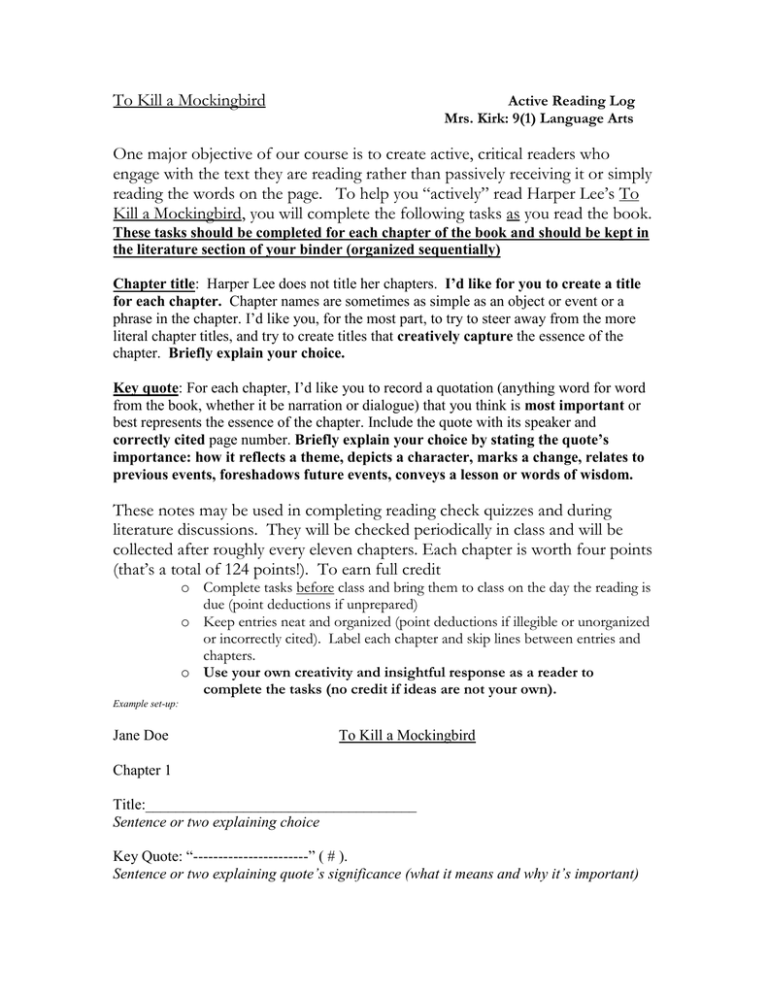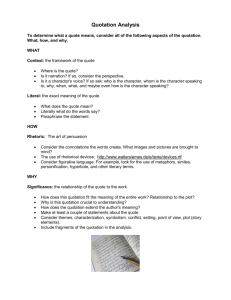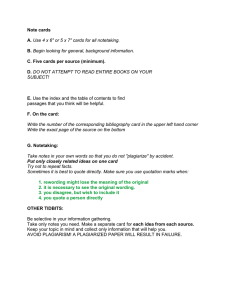To Kill a Mockingbird
advertisement

To Kill a Mockingbird Active Reading Log Mrs. Kirk: 9(1) Language Arts One major objective of our course is to create active, critical readers who engage with the text they are reading rather than passively receiving it or simply reading the words on the page. To help you “actively” read Harper Lee’s To Kill a Mockingbird, you will complete the following tasks as you read the book. These tasks should be completed for each chapter of the book and should be kept in the literature section of your binder (organized sequentially) Chapter title: Harper Lee does not title her chapters. I’d like for you to create a title for each chapter. Chapter names are sometimes as simple as an object or event or a phrase in the chapter. I’d like you, for the most part, to try to steer away from the more literal chapter titles, and try to create titles that creatively capture the essence of the chapter. Briefly explain your choice. Key quote: For each chapter, I’d like you to record a quotation (anything word for word from the book, whether it be narration or dialogue) that you think is most important or best represents the essence of the chapter. Include the quote with its speaker and correctly cited page number. Briefly explain your choice by stating the quote’s importance: how it reflects a theme, depicts a character, marks a change, relates to previous events, foreshadows future events, conveys a lesson or words of wisdom. These notes may be used in completing reading check quizzes and during literature discussions. They will be checked periodically in class and will be collected after roughly every eleven chapters. Each chapter is worth four points (that’s a total of 124 points!). To earn full credit o Complete tasks before class and bring them to class on the day the reading is due (point deductions if unprepared) o Keep entries neat and organized (point deductions if illegible or unorganized or incorrectly cited). Label each chapter and skip lines between entries and chapters. o Use your own creativity and insightful response as a reader to complete the tasks (no credit if ideas are not your own). Example set-up: Jane Doe To Kill a Mockingbird Chapter 1 Title:____________________________________ Sentence or two explaining choice Key Quote: “-----------------------” ( # ). Sentence or two explaining quote’s significance (what it means and why it’s important) Model your own notes on this example. Jane Doe The Prince and the Pauper Notes Chapter one: Title: “Silks and Rags” This chapter contrasts the births of the two main characters: one, Prince Edward, who was born in silks and whose birth caused great celebration, an the other, Tom Canty, who was born in rags to a family who didn’t want him. Quote: “But there was no talk about the other baby, Tom Canty, lapped in poor rags, except among the family of paupers, whom he had just come to trouble with his existence” (1). Interesting that the birth of a baby would “trouble” people instead of bring them joy. They probably couldn’t afford him. This sad commentary creates a depressing mood. Chapter two: Title: “Royal Dreams and Offal Reality” Tom lives in poverty and his abused by his dad and grandmother, but he finds temporary refuge in his dreams of being a prince. Quote: “And when he awoke in the morning and looked upon the wretchedness about him, his dream had its usual effect—it intensified the sordidness of his surroundings a thousandfold” (6). It’s true that sometimes seeing what others have makes us feel even worse about our own situations. This line seems to foreshadow that Tom’s dreams will have a greater significance. ***Note the punctuation of the cited quote. The page number (and only the number) is placed in parenthesis AFTER the quotation marks but BEFORE the period. Notice that neither a period nor a comma is placed inside of the quotation. Special circumstances: If your quote is a question or exclamation, include the question mark/exclamation point inside of the quotation and place a period after the parenthesis. Example: “Don’t eat things you find, Scout!” (78). If your selected quote includes narration and dialogue, follow this model: “Scout said aloud, ‘Now I know why Boo doesn’t come outside. He doesn’t want to’” (34). Place double quotation marks around the entire quotation, and single quotation marks around the dialogue within the quotation.




